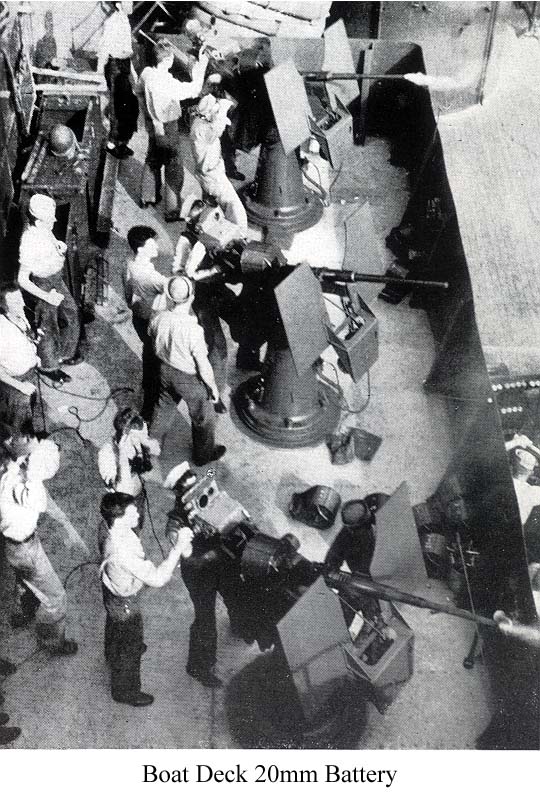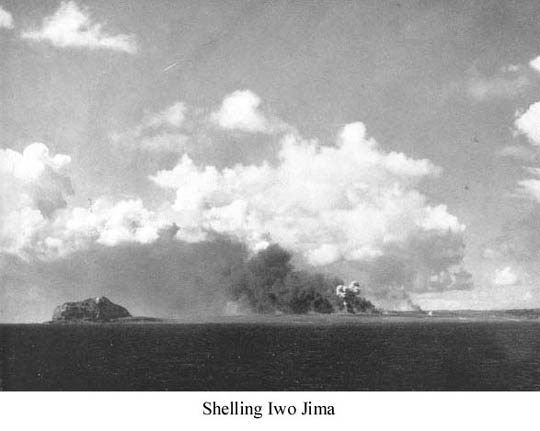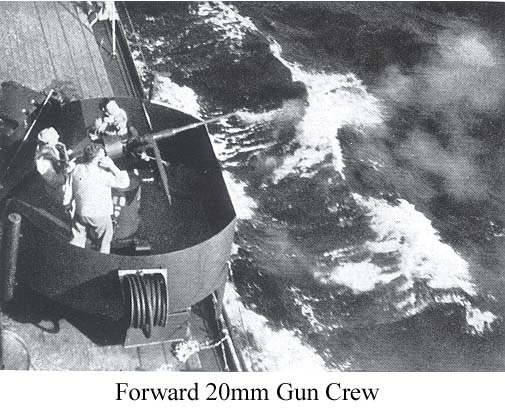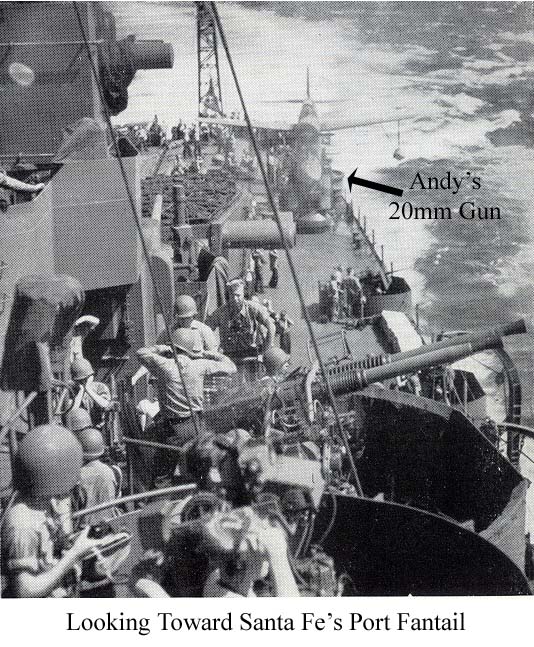|
Operating with familiar Task Group 58.2, the SANTA FE jockeyed around the carriers on the afternoon of 11 June as the first strike was launched against the Marianas. Daily thereafter, sustained blows fell on Saipan, Tinian and Guam, with "58's" planes swarming to support Lt. General Holland M. "Howlin’ Mad" Smith's 2nd Division Marines as they lanced into the southwest quadrant of Saipan 15 June. Task Force 58 was reorganized on the 16th to meet a large Japanese surface force approaching from the Philippines, but the SANTA FE remained with her carrier charges. Skipper Wright and crew found themselves right in the middle of the Battle of the Philippine Sea. Ceiling and visibility were unlimited on the morning of 19 June, as wave upon wave of enemy aircraft soared in from every corner of the horizon. The Japanese, making use of their fields on Guam and Tinian, were able to make a one-way trip of it from carrier deck to airfield, thus doubling their range. U.S. carrier planes were vectored to meet them, and the Marianas "Turkey Shoot" was in progress. SANTA FE guns banged away at dive bombers which twice attacked her group, downing a few, scattering the rest.
Dogfights were observed continuously as Americans and Japanese tangled in mortal combat high over the ships whose fate they were deciding. The cobalt blue heavens, already liberally flecked with black, puffy pinheads from exploding AA shells, were marred by wispy, crisscrossing vapor trails. Recapitulation at twilight showed that Task Force 58 and subsidiaries had tallied some 400 of the Mikado's winged demons. On the 20th, the "Turkey Shoot" was followed up by an all out, exceedingly long-range aerial onslaught against the Imperial forces which, although it did not result in the hoped-for destruction of the enemy surface fleet, did cost the Japanese three aircraft carriers and two of their critically short fleet tankers, together with severe damage to vessels of diversified nomenclature. Decimation of the trained air groups of three enemy carrier divisions engaged in the 19 June fiasco was a gratifying result however. Nipponese carrier aviation had taken the final count. It was the night of 20 June 1944. Only wavering shadows marked the ships of Task Force 58 scattered over the placid Philippine Sea. Of the 216 planes which had taken off that afternoon to strike at the Japanese fleet, 20 had been destroyed in battle and many were going down due to fuel exhaustion. All of them tired, many wounded, the pilots were scanning the shadow-cloaked sea for their carriers. On the bridge of his Flagship, Admiral Marc Mitscher made a decision which caused no little anxiety throughout the huge armada. Ordered Admiral Mitscher: "Turn on the lights." In response, the Philippine Sea was suddenly ablaze with all the brilliance of a motion picture. premiere. On the cruiser SANTA FE, 36-inch searchlights were flicked into operation, forming infinite pencils of light on both. sides. When no more planes were airborne, CL-60 reversed course to the west at about 2330, and joined the task force in a pursuit of the swiftly retiring enemy. Contact was not reestablished and low fuel supplies forced an end to the chase. Task Group 58.2. turned eastward 21 June, left the escort carriers to maintain control of the air at Saipan, and gathered at Eniwetok on 27 June 1944 for refueling, food and ammunition.
Six hundred miles north of the besieged Marianas lay Iwo Jima, diminutive isle of volcanic ash and boulders, also an important roost for the wings of the Rising Sun. On 30 June the SANTA FE left Eniwetok and nosed northwest to the Bonins with her carrier cohorts. Independence Day 1944 was heralded by a brilliant pyrotechnic display in the Bonins, as Task Force 58 carried out a withering air-sea bombardment against Iwo and Chichi Jima. Shuttling east and then south of 'the island on the afternoon of the 4th, the SANTA FE shelled Iwo Jima with direct fire at ranges between 9,000 and 16,000 yards.. From the number and size of fires visible on the island at the completion of the artillery assault, it was considered that airdromes hangers and dumps were about seventy-five per cent destroyed. Cruiser SANTA FE's Kingfishers were active too. While spotting for the gunnery department, one of them was tackled by three fighters. Before he was forced to land, he sent one of the Zeros spiraling in flames. While the ditched Kingfisher's personnel were being rescued by a destroyer, her spotting twin picked up a fighter pilot forced down off Haha Jima. By 5 July the SANTA FE was speeding south with the task force for a return engagement in the Marianas. Assembling in an area some 100 miles east of Guam, the carriers began launching on 6 July a series of alternating strikes against Guam and Rota. Enemy planes stabbed at the formation during the nights of 10 and 11 July, but were shot down by U. S. night fighters. When Marines hit the beaches at Guam 21 July, the carriers put in at captured Saipan, augmented their bomb stock, then raced south with their cruiser-destroyer screen to bomb Yap, Weleai, Ulithi and Palau. Yap was the target of the SANTA FE's Task Group 58.1 and, beginning on the afternoon of 25 July, the Navy planes carried out daily assaults which met negligible resistance. When the operations were completed 28 July, the task group returned to Saipan to re-bomb, but were prevented from doing so by the heavy seas running. Cruiser SANTA FE anchored briefly at Saipan for 5 hours on 2 August, then got underway with. the ubiquitous " 58.1" at 1300. Again it was the Bonin Islands, with the first sweep scheduled for 0900 on 4 August. At 0800 that date, search planes reported a Japanese convoy zigzagging out of Chichi Jima and the SANTA FE's carriers were given the "go get 'em" signal. After a 2-hour search the planes reported, at 1130, that they were attacking the Japanese ships. Cruiser Division 13 and Destroyer Division 91 left the task group at. 1241, went at a 30-knot clip between Ototo and Yome Jima, and arrived on the scene at about 1730. Promptly the destroyers caught a small Japanese craft about the size of an LST in their gunsights, picked her apart with shellfire, and sent her to the bottom. DesDiv 91 formed an attack group ahead of the cruisers and at 1845 came upon, and sank a small coiler.
Another straggler from the battered convoy, later identified as the destroyer MATSU, was sighted at 1924. Six minutes later the SANTA FE and the other cruisers commenced firing on the target. A running gun fight ensued, with the return fire from MATSU's smaller guns proving fairly accurate. But destroyer MATSU soon found her thin skin badly holed, with water steadily welling up belowdecks. When the cruisers ceased fire at 2040, destroyers were ordered in to finish her off, but the stricken MATSU slipped under the surface before they could reach her. From there the cruisers went northwest to hunt more game. SANTA FE lookouts sighted a large landing barge, relayed their find to the guns which soon set the target afire. At 2145 the rest of the cruisers caught a large supply ship and sank it. Further prowling to the north and east proved futile, and the cruisers called it a day, turned south to rake Chichi Jima. Enroute to Chichi, the SANTA FE's group was harassed by enemy planes which made several sporadic attacks. While staving them off, the SANTA FE also fired on and damaged a large sampan which was passed close aboard. By 0800 the- planes were gone and the ships formed into a bombardment disposition.
Cruiser Division 13 made three runs on shipping in Chichi Jima's harbor of Futamiko, succeeded in silencing an irksome shore battery before it retired on 1119 on 5 August. Poor visibility made results hard to determine, but several ships had been sunk, a seaplane base damaged and fires started among the wharves and warehouses. Admiral DuBose took his cruisers southeast to anchor at Eniwetok 11 August. For the SANTA FE, this completed a 42-day cruise during which she steamed 17,656 miles, averaging 420 miles daily. At Eniwetok the carrier task force was revamped and placed under the command of Admiral William F. "Bull" Halsey. USS SANTA FE was designated a unit of Task Group 38.3. |

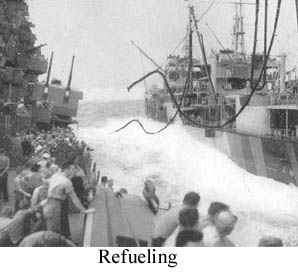 By this time, the projected invasion of the Marianas Islands had long since
outgrown the map consultation stage. America had the forces plus the initiative
to pierce Japan's inner defense perimeter; in advance U.S. bases the salient
sword was being sharpened. USS SANTA FE remained at Kwajalein until 13 May, on
which date she got underway for Majuro. Anti-aircraft practice was emphasized
during the remainder of May at Majuro. Task Force 58 was swollen with planes,
shells and gasoline as it pulled out of the Marshalls on 6 June 1944.
By this time, the projected invasion of the Marianas Islands had long since
outgrown the map consultation stage. America had the forces plus the initiative
to pierce Japan's inner defense perimeter; in advance U.S. bases the salient
sword was being sharpened. USS SANTA FE remained at Kwajalein until 13 May, on
which date she got underway for Majuro. Anti-aircraft practice was emphasized
during the remainder of May at Majuro. Task Force 58 was swollen with planes,
shells and gasoline as it pulled out of the Marshalls on 6 June 1944.